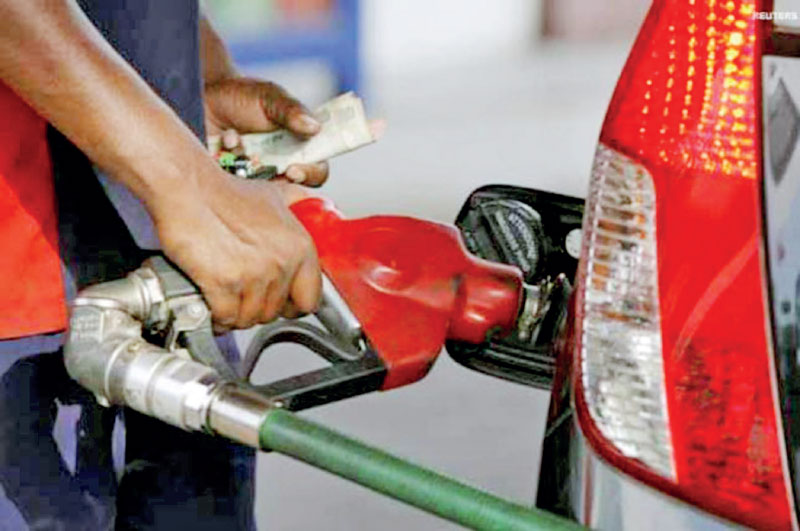Monday, 10 April 2023 01:16 – – 30
 If the Minister, a schoolteacher and a three-wheeler driver all use the formula, and independently access the data sources on the internet, all should get the same answer for the selling price of petrol
If the Minister, a schoolteacher and a three-wheeler driver all use the formula, and independently access the data sources on the internet, all should get the same answer for the selling price of petrol
 The first-ever introduction of the fuel pricing formula was in year 2002. At that time, there were at least a few honest politicians and officials. They published the formula in the newspapers in great detail and went on to provide the sources of data and results of calculations. There was a newspaper notice on a fixed day each month, summarising the calculations. As elections of 2005 approached, international oil prices rose, and the government that spoke so highly of the formula, was scared to apply the formula, and raise the local prices. “My government will bear the difference in costs”, was the all too familiar phrase.
The first-ever introduction of the fuel pricing formula was in year 2002. At that time, there were at least a few honest politicians and officials. They published the formula in the newspapers in great detail and went on to provide the sources of data and results of calculations. There was a newspaper notice on a fixed day each month, summarising the calculations. As elections of 2005 approached, international oil prices rose, and the government that spoke so highly of the formula, was scared to apply the formula, and raise the local prices. “My government will bear the difference in costs”, was the all too familiar phrase.
The electorate was wiser. They chased the cheating government away at the elections, in spite of the “petrol” bribe.
Preparing a fuel pricing formula does not need a genius. A good knowledge of the petroleum supply industry and an elementary knowledge of algebra will be adequate. Both attributes seem to be in short supply across the political spectrum for the past two decades and more.
2018-2019 era
Instead of publishing the formula, its inputs, sources of input and outputs, mathematically illiterate politicians of the 2018-2019 era insulted the wisdom of Sri Lankans (63% of whom have passed OL Mathematics), by displaying a poster in Parliament that said:
MRP = V1 + V2 + V3 + V4
And stopped at that, laughing at the opposition, and through the parliament camera, to the public.
A separate Finance Ministry document said:
V1: Landed Cost (Rs/litre)
V2: Processing Cost (Rs/litre)
V3: Administrative Cost (Rs/litre)
V4: Taxation (Rs/litre)
“People can now start to calculate the oil prices as a hobby before 10th of every month if they are good with numbers,” laughed the finance minister at that time, flanked by his silver-haired deputy (now an opposition MP) and the Treasury Secretary, both of whom did not appear to understand what the finance minister was saying.
Adequate sources were not presented to the public, to independently verify the values used for V1, V2, V3 and V4. Naturally, the opposition objected. “To alter the local market prices of fuel as and when the world market prices change, why should there be a government?” barked one former Energy Minister.
So, the formula of 2018, vague as it was, went on for about one year, until it was ridiculed and discarded by the new administration of November 2019.
Formula again in 2022
“Govt. introduces pricing formula for fuel” was a major news item in Daily FT, on 25 May 2022. The Government announced: “A seven-member committee comprising officials of the Ministry of Power and Energy, Ministry of Finance, Central Bank of Sri Lanka, Ceylon Petroleum Corporation, Lanka IOC, Consumer Affairs Authority and a party selected by the Secretary of the Ministry of Power and Energy will determine the fuel prices.”
So where are the calculations of this committee? Where is the “formula”?
Since then, once in a few months, we hear about the fuel pricing formula. However, the formula itself has never been published.
Any student of mathematics will know that a formula has
- A left-hand side and a right-hand side
- A list of input data and their values, including their sources (where did the data come from) along with any assumptions and why such assumptions were made
- The result of the calculation
What is most important is that all sources of data should be possible to be independently verified. If the Minister, a schoolteacher and a three-wheeler driver all use the formula, and independently access the data sources on the internet, all should get the same answer for the selling price of petrol. There cannot be any difference.
So in May 2022, the Government (previously the Opposition) made an about turn, said “mea culpa”, and reintroduced the formula. Or at least said the formula is now back in use. Just like the government of 2018, in 2022 too, the formula, inputs and outputs were never published.
Alas! Last week the Government said, “The price reduction is in line with an agreement with the International Monetary Fund, which includes adjusting fuel subsidies and prices based on production costs and global oil prices.” So all these days since May 2022, the formula has not been operational, and Sri Lankans were over-charged for fuel, it seems. It appears that IMF had to tell the Government, “Get back to the formula!”
Sri Lankans have no choice. The formula was said to be in use since May 2022, but now the Government says, the formula will now be used as dictated by IMF and reduces the prices.
None of the politicians, both Government and Opposition, appear to be able to understand the formula, its inputs, and outputs.
And now we are told that private operators will be allowed into the retail petroleum market. Surely, now there are more reasons for the formula to continue to be hidden from the public.
Currently a litre of bulk gasoline (petrol) in the international market is about $ 0.65, which works out to be Rs. 214 per litre. How that becomes Rs. 340 per litre when it is delivered at the petrol pump, is what the formula should show, in great detail, including costs to get it to the pump and the taxes. Then the public can be happy that from every litre of petrol, Rs. 100 or more goes to maintain free healthcare and education, and the politicians. If there is an amount about which the public is not supposed to know, that too can be stated in the formula, using terms such as “premium”, “surcharge” or “depreciation”.
Politicians when they go to opposition and officials when they retire, will ask the formula to be published, for sure. The same goes with pricing LPG, which has a formula, but not published.
If the public like to understand what transparency of pricing means, take a look at the Public Utilities Commission (PUC) website for the pricing of renewable energy-based electricity sold to the grid in 2012.
See: https://web.pucsl.gov.lk/english/wp-content/uploads/2012/12/Decision-on-NCRE-Purchase-Tariffs-2012-2013-Web-Vesion.pdf
These renewable energy price calculations in 2012 were challenged and modified later, prices dropped by 35% when competitive bids were invited in 2015, but what is important is the degree to which the calculations were described, sources specified, even to facilitate a discussion.
But not anymore. Ask PUC or Sri Lanka Sustainable Energy Authority (the guardians of renewable energy) for the calculation of the renewable energy prices for 2023!
Those were the days!

